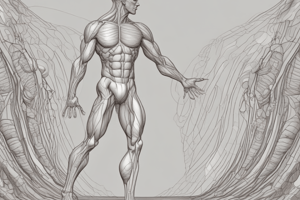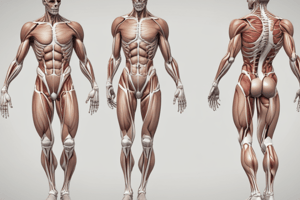Podcast
Questions and Answers
What condition is characterized by bony grating or a block during range of motion (ROM)?
What condition is characterized by bony grating or a block during range of motion (ROM)?
- Osteoarthritis (correct)
- Myositis ossificans
- Bursitis
- Chondromalacia
Which of the following best describes the phenomenon where a patient may not reach the end of range of motion due to pain rather than mechanical blockage?
Which of the following best describes the phenomenon where a patient may not reach the end of range of motion due to pain rather than mechanical blockage?
- Hard end-feel
- Empty end-feel (correct)
- Soft end-feel
- Firm end-feel
Which concept describes the interconnectedness of movement segments and muscles in human movements?
Which concept describes the interconnectedness of movement segments and muscles in human movements?
- Movement Continuum Theory
- Open and closed kinetic chain
- Kinematic chain (correct)
- Anatomy and biomechanics
What term is used to describe the phenomenon when muscles are unable to generate maximum force due to being stretched too far?
What term is used to describe the phenomenon when muscles are unable to generate maximum force due to being stretched too far?
Which of the following is NOT typically associated with acute joint inflammation?
Which of the following is NOT typically associated with acute joint inflammation?
What type of movement involves the muscle being contracted while the load is being applied to it?
What type of movement involves the muscle being contracted while the load is being applied to it?
Which factor does NOT typically influence muscle strength according to age and gender?
Which factor does NOT typically influence muscle strength according to age and gender?
The term 'labels' of muscles according to their roles refers to what concept?
The term 'labels' of muscles according to their roles refers to what concept?
What characterizes an open kinematic chain (OKC)?
What characterizes an open kinematic chain (OKC)?
In a closed kinematic chain (CKC), which of the following statements is true?
In a closed kinematic chain (CKC), which of the following statements is true?
Which type of muscle contraction occurs when there is no change in muscle length?
Which type of muscle contraction occurs when there is no change in muscle length?
What happens during a concentric contraction?
What happens during a concentric contraction?
Which scenario exemplifies eccentric contraction?
Which scenario exemplifies eccentric contraction?
When would internal torque be less than external torque?
When would internal torque be less than external torque?
Which statement correctly describes the differences between open and closed kinematic chains?
Which statement correctly describes the differences between open and closed kinematic chains?
What is required for isometric force generation?
What is required for isometric force generation?
What is the primary function of agonist muscles in motion?
What is the primary function of agonist muscles in motion?
Which of the following statements about antagonists is true?
Which of the following statements about antagonists is true?
What role do synergist muscles play in movement?
What role do synergist muscles play in movement?
In the context of muscle function, what is a neutralizer?
In the context of muscle function, what is a neutralizer?
Which of the following best describes the role of stabilizer muscles?
Which of the following best describes the role of stabilizer muscles?
The term 'conjoint' refers to which type of muscle action?
The term 'conjoint' refers to which type of muscle action?
Which muscle action is primarily associated with the biceps brachii in elbow flexion?
Which muscle action is primarily associated with the biceps brachii in elbow flexion?
What is the relationship between the brachioradialis and brachialis during elbow flexion?
What is the relationship between the brachioradialis and brachialis during elbow flexion?
What is the primary role of stabilizers in muscle movement?
What is the primary role of stabilizers in muscle movement?
How is physical fitness defined?
How is physical fitness defined?
Which of the following is NOT one of the fundamental principles for resistance training programming?
Which of the following is NOT one of the fundamental principles for resistance training programming?
In the context of muscle strengthening, what does the term 'overload' refer to?
In the context of muscle strengthening, what does the term 'overload' refer to?
What is the best description of exercise as defined in the provided content?
What is the best description of exercise as defined in the provided content?
Which muscle group is referenced as a fixator during shoulder rotation?
Which muscle group is referenced as a fixator during shoulder rotation?
How does muscle re-education primarily benefit individuals?
How does muscle re-education primarily benefit individuals?
Which principle emphasizes the need for consistency in resistance training?
Which principle emphasizes the need for consistency in resistance training?
What is the main consequence of prolonged disuse on muscle fibers?
What is the main consequence of prolonged disuse on muscle fibers?
How does resistance training affect muscle fiber composition?
How does resistance training affect muscle fiber composition?
Which of the following statements about muscle fiber types is correct?
Which of the following statements about muscle fiber types is correct?
What characterizes active movements?
What characterizes active movements?
What does the convex-concave rule describe?
What does the convex-concave rule describe?
Which type of movement is characterized by muscles generating tension without changing length?
Which type of movement is characterized by muscles generating tension without changing length?
In what scenario can there be a unique transition of muscle fiber types?
In what scenario can there be a unique transition of muscle fiber types?
What distinguishes active-assisted movements from passive movements?
What distinguishes active-assisted movements from passive movements?
Flashcards are hidden until you start studying
Study Notes
End-Feels
- Hard End Feel means that the movement is restricted by bone contacting bone
- Soft End Feel means that movement is stopped by soft tissue compression.
- Firm End Feel is a springy sensation that is caused by muscle or capsular stretching.
- Empty End Feel means that movement is stopped by pain before the end of range of motion.
Muscle Roles
- Agonist muscles are the prime movers and contract to produce desired motion, they can be concentric, eccentric, or isometric.
- Antagonist muscles perform the opposite action of the agonist muscle.
- Synergist muscles help the agonist muscle to produce the desired motion.
- Stabilizers muscles keep a joint steady while other movements take place.
Open Chain vs Closed Chain
- Open Kinematic Chain describes joints moving freely with no external resistance
- Closed Kinematic Chain describes joints that are stopped by external resistance
- The chain can be made up of linked segments (for example, the pelvis, thigh, leg and foot).
Muscle Force Generation
- Isometric Force involves muscle force without any change in muscle length, where muscle torque is equal to load torque,
- Concentric Force involves muscle force with shortening of the muscle, where muscle torque is greater than the load torque.
- Eccentric Force involves muscle force with the lengthening of the muscle, where muscle torque is less than the load torque.
Prolonged Activity Changes
- Prolonged Activity leads to a muscle hypertrophy effect and increased cross-sectional area (CSA), increasing muscle force, with Type II muscle fibers changing more than Type I.
- Prolonged Disuse leads to an atrophy effect and decreased cross-sectional area (CSA), with Type I muscle fibers changing more than Type II.
Movement Continuum Theory
- Movement is described through specific planes and axes.
- Movements can be described as translation (linear movement) or rotation (angular movement).
- Movements can be active,passive or active-assisted and are defined by the role of the person and the way that they move.
- The convex-concave rule describes the relationship between the joint surfaces and the type of movement.
Studying That Suits You
Use AI to generate personalized quizzes and flashcards to suit your learning preferences.




